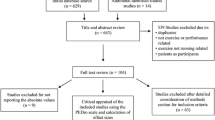Abstract
This study examined the effect of wearing different grades of graduated compression stockings (GCS) on physiological and perceptual measures during and following treadmill running in competitive runners. Nine males and one female performed three 40-min treadmill runs (80 ± 5% maximal oxygen uptake) wearing either control (0 mmHg; CON), low (12–15 mmHg; LO-GCS), or high (23–32 mmHg; HI-GCS) grade GCS in a double-blind counterbalanced order. Oxygen uptake, heart rate and blood lactate were measured. Perceptual scales were used pre- and post-run to assess comfort, tightness and any pain associated with wearing GCS. Changes in muscle function, soreness and damage were determined pre-run, immediately after running and 24 and 48 h post-run by measuring creatine kinase and myoglobin, counter-movement jump height, perceived soreness diagrams, and pressure sensitivity. There were no significant differences between trials for oxygen uptake, heart rate or blood lactate during exercise. HI-GCS was perceived as tighter (P < 0.05) and more pain-inducing (P < 0.05) than the other interventions; CON and LO-GCS were rated more comfortable than HI-GCS (P < 0.05). Creatine kinase (P < 0.05), myoglobin (P < 0.05) and jump height (P < 0.05) were higher and pressure sensitivity was more pronounced (P < 0.05) immediately after running but not after 24 and 48 h. Only four participants reported muscle soreness during recovery from running and there were no differences in muscle function between trials. In conclusion, healthy runners wearing GCS did not experience any physiological benefits during or following treadmill running. However, athletes felt more comfortable wearing low-grade GCS whilst running.





Similar content being viewed by others
References
Ali A, Caine MP, Snow BG (2007) Graduated compression stockings: physiological and perceptual responses during and after exercise. J Sports Sci 25:413–419
Ali A, Creasy RH, Edge JH (2010) The effect of graduated compression stockings on running performance. J Strength Cond Res (in press)
Armstrong RB, Warren GL, Warren JA (1991) Mechanisms of exercise-induced muscle fibre injury. Sports Med 12:184–207
Bailey DM, Davies B, Young IS, Hullin DA, Seddon PS (2001) A potential role for free radical-mediated skeletal muscle soreness in the pathophysiology of acute mountain sickness. Aviat Space Environ Med 72:513–521
Benigni JP, Sadoun S, Schadeck M, Rastel D (2001) Marathon runners, veins, and compression stockings. Phlebologie 54:171–217
Berry MJ, McMurray RG (1987) Effects of graduated compression stockings on blood lactate following an exhaustive bout of exercise. Am J Phys Med Rehab 61:121–132
Borg GAV (1973) Perceived exertion: a note on ‘history’ and methods. Med Sci Sports Exerc 5:90–93
Bringard A, Perrey S, Belluye N (2006) Aerobic energy cost and sensation response during submaximal running exercise—positive effects of wearing compression tights. Int J Sports Med 27:373–378
Byrne B (2001) Deep vein thrombosis prophylaxis: the effectiveness and implications of using below-knee or thigh-length graduated compression stockings. Heart Lung 30:277–284
Chatard JC (1998) Elastic bandages, recovery and sport performance. In: Proceedings of the Techtextil symposium. Health and protective textiles, Lyon, France, pp 79–84
Chatard JC, Atlaoui D, Farjanel J, Louisy F, Rastel D, Guezennec CY (2004) Elastic stockings, performance and leg pain recovery in 63-year-old sportsmen. Eur J Appl Physiol 93:347–352
Duffield R, Portus M (2007) Comparison of three types of full-body compression garments on throwing and repeat-sprint performance in cricket players. Br J Sports Med 41:409–414
Hardy CJ, Rejeski WJ (1989) Not what, but how one feels: the measurement of affect during exercise. J Sport Exerc Psychol 11:304–317
Johnson DL, Bahamonde R (1996) Power output estimate in university athletes. J Strength Cond Res 10:161–166
Jones AM, Doust JH (1996) A 1% treadmill grade most accurately reflects the energetic cost of outdoor running. J Sports Sci 14:321–327
Jonker MJ, de Boer EM, Adèr HJ, Bezemer PD (2001) The oedema-protective effect of Lycra® support stockings. Dermatology 203:294–298
Kraemer WJ, Bush JA, Bauer JA et al (1996) Influence of compression garments on vertical jump performance in NCAA Division I volleyball players. J Strength Cond Res 10:180–183
Kraemer WJ, Volek JS, Bush JA et al (2000) Influence of compression hosiery on physiological responses to standing fatigue in women. Med Sci Sports Exerc 32:1849–1858
Kuipers H, Janssen GME, Bosnan F, Frederik PM, Guerten P (1989) Structural and ultrastructural changes in skeletal muscle associated with long-distance training and running. Int J Sports Med 10:S156–S159
Lawrence D, Kakkar VV (1980) Graduated, static, external compression of the lower limb: a physiological assessment. Br J Surg 67:119–121
Lewis CE, Antoine J, Meuller C et al (1976) Elastic compression in the prevention of venous stasis. Am J Surg 132:739–743
Mayberry JC, Moneta GL, DeFrang RD, Porter JM (1991) The influence of elastic compression on deep venous hemodynamics. J Vasc Surg 13:91–99
Noonan TJ, Garrett WE (1999) Muscle strain injury: diagnosis and treatment. J Am Acad Orthop Surg 7:262–269
Shellock FG, Prentice WE (1985) Warming up and stretching for improved physical performance and prevention of sports-related injuries. Sports Med 2:267–278
Sigel B, Edelstein AL, Savitch L (1975) Type of compression for reducing venous stasis. Arch Surg 110:171–175
Svebak E, Murgatroyd S (1985) Metamotivational dominance: a multimethod validation of reversal theory constructs. J Personal Soc Psychol 48:107–116
Thompson D, Nicholas CW, Williams C (1999) Muscular soreness following prolonged, intermittent, high-intensity shuttle running. J Sports Sci 17:387–395
van Geest AJ, Franken CPM, Neumann HAM (2003) Medical elastic compression stockings in the treatment of venous insufficiency. Curr Probl Derm 31:98–107
Acknowledgments
The authors would like to thank Invista International S.à.r.l. (Geneva, Switzerland) for funding this study and Julius Zorn GmbH (Aichach, Germany) for providing the compression garments used by the participants. We would also like to thank all the participants involved in this study and the research assistants who assisted with data collection. The authors declare that they have no conflicts of interest.
Author information
Authors and Affiliations
Corresponding author
Additional information
Communicated by Niels Secher.
Rights and permissions
About this article
Cite this article
Ali, A., Creasy, R.H. & Edge, J.A. Physiological effects of wearing graduated compression stockings during running. Eur J Appl Physiol 109, 1017–1025 (2010). https://doi.org/10.1007/s00421-010-1447-1
Accepted:
Published:
Issue Date:
DOI: https://doi.org/10.1007/s00421-010-1447-1




